Imagine walking on white sand dunes that stretch as far as the eye can see, a surreal landscape that’s unlike anywhere else on Earth. Located in the heart of New Mexico, White Sands National Park is a breathtaking natural wonder that attracts visitors from all over the world.
You can explore the national park and discover its unique geological formations, comprised predominantly of gypsum. The dunes cover over 275 square miles of the Chihuahuan Desert, creating an otherworldly landscape that’s a must-see.
As you visit, you’ll understand why this natural wonder was upgraded to a national park in 2019, recognizing its ecological and recreational significance. Get ready to experience the magic of this sand desert and make the most of your trip.
Discovering the Magical White Sand Dunes
As you step into White Sands National Park, you’re immediately enveloped by the surreal beauty of its vast, white sand dunes. The sands are unique here because they are comprised of the mineral gypsum, which gives them their uniquely white color. In fact, it is the largest gypsum dunefield in the world.
The story of how this white sand came to be is fascinating. Millions of years ago, this area of New Mexico was the Permian Sea. When the sea dried up, it left layers of gypsum (a mineral found in rocks). Over time, with the forces of water, wind, and sun, these gypsum crystals were broken down into the fine white sand you see today.
The sand dunes of White Sands are not just visually stunning; they also offer a unique experience. Unlike typical sand dunes, the gypsum composition of these dunes makes them cool to the touch, even on hot days. The dunes are constantly shifting and moving, creating new patterns and formations that make each visit unique.
| Characteristics | White Sands | Typical Sand Dunes |
|---|---|---|
| Composition | Gypsum | Silica |
| Temperature | Cool to touch | Hot |
| Formation | Constantly shifting | Relatively stable |
Visitors to the park can explore the fascinating geological history, understand the natural forces that created this landscape, and appreciate the stark contrast between the brilliant white sands and the blue New Mexico sky, creating one of the most photogenic landscapes in the American Southwest.
Park Information: Hours, Fees, and Location
Before you plan your trip to White Sands National Park, it’s essential to know the park’s operational hours, fees, and location. White Sands National Park is open daily from 7:00 am to sunset year-round, with the exception of Thanksgiving and Christmas.
To enter the national park, the entrance fee is $25 per vehicle for up to 4 people. If you’re on a motorcycle, the fee is $20. The entrance fee allows you to come and go as many times as you want for 7 consecutive days from purchase.
Key Information:
- Plan your visit with essential information about park hours (7:00 am to sunset daily, closed on Thanksgiving and Christmas) and entrance fees ($25 per vehicle for up to 4 people).
- Understand the best seasons to visit White Sands National Park – fall, winter, and spring offer the most comfortable temperatures for exploring the dunes.
- Learn about the extreme summer heat (average highs of 97°F in June and July) and how to prepare if you must visit during this season.
- Consider the weather patterns that affect the park, including late afternoon thunderstorms from July through September and high winds in spring.
- Discover how to maximize your entrance fee by using the 7-day pass to visit multiple times during your stay in southern New Mexico.
Best Time to Visit White Sands National Park
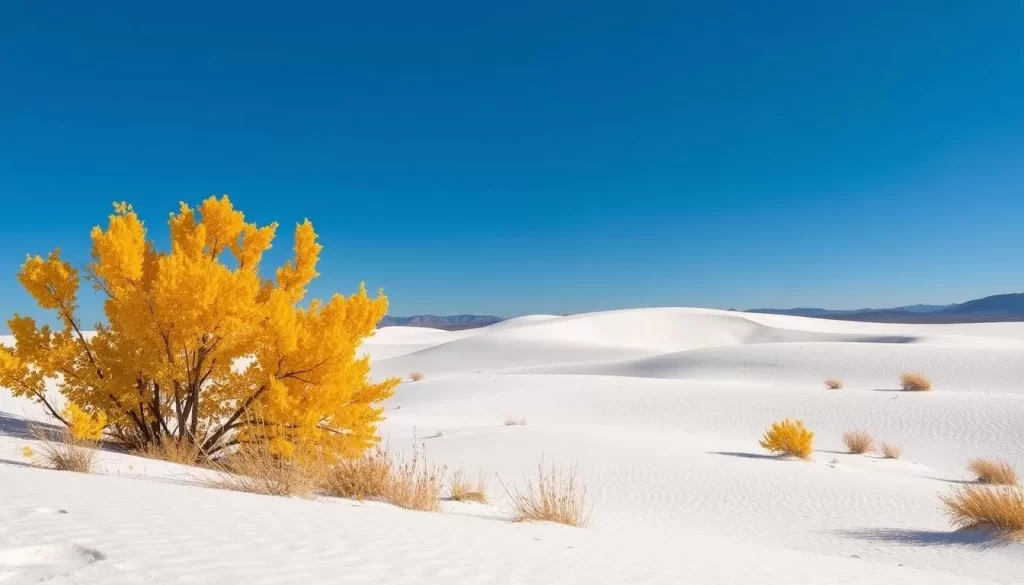
The best time to visit White Sands National Park is during the fall, winter, and spring. As with any desert, the temperature highs and lows have pretty big swings from mid-day to night time.
Visiting during the fall, winter, or spring allows you to enjoy the park’s beauty without the extreme heat of the summer months. If you do plan to visit in the summer, be prepared for temperatures that can soar to average highs of 97°F in June and July.
White Sands National Park, New Mexico: Best Things to Do – Top Picks
White Sands National Park is a unique outdoor destination in the American Southwest, offering numerous activities that cater to different interests. Whether you’re an adventure enthusiast or just looking to enjoy nature, White Sands has something for everyone.
One of the top things to do at White Sands National Park ishiking. The park boasts five official trails, ranging from easy to challenging, allowing visitors to explore the beautiful white dunes at their own pace. You can also venture off the beaten path and “choose your own adventure” among the dunes.
Another popular activity isdune sledding, a thrilling experience that involves sliding down the pristine white sand slopes on a sled. This activity is enjoyed by visitors of all ages and is a great way to experience the park’s unique landscape.
For photography enthusiasts, White Sands offersstunning photography opportunities, especially during the golden hour when the contrast between the white sand and blue skies is at its most dramatic. Capturing the beauty of this natural wonder is a must-do for any visitor.
To deepen your understanding of this remarkable ecosystem, consider planning your trip aroundranger programs and special events. These programs offer insights into the park’s unique geology, flora, and fauna, enhancing your overall experience.
Here’s a summary of the top activities to enjoy at White Sands National Park:
| Activity | Description | Best Time |
|---|---|---|
| Hiking | Explore the park’s five official trails | Early morning or late afternoon |
| Dune Sledding | Slide down the white sand slopes | Anytime, but best during calm weather |
| Photography | Capture the contrast between white sand and blue skies | Golden hour (early morning or late afternoon) |
| Ranger Programs | Learn about the park’s geology, flora, and fauna | Check park schedule for program times |
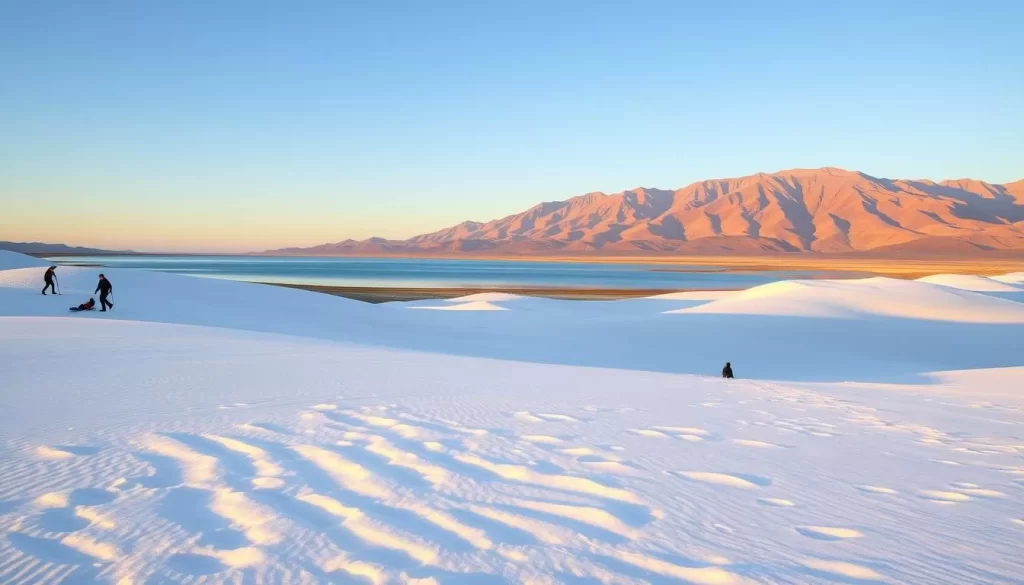
By incorporating these activities into your trip, you’ll be able to fully experience the beauty and wonder of White Sands National Park.
Exploring Dunes Drive
As you embark on your journey through White Sands National Park, you’ll find yourself on Dunes Drive, a scenic route that showcases the park’s breathtaking beauty. Dunes Drive is an 8-mile journey to the park’s farthest point, making it a 16-mile round-trip adventure.
The road takes you through the stunning white sand gypsum dunes, forming a loop that brings you back to the starting point. The first four miles are paved, while the remainder is made of packed gypsum sand, suitable for all vehicles.
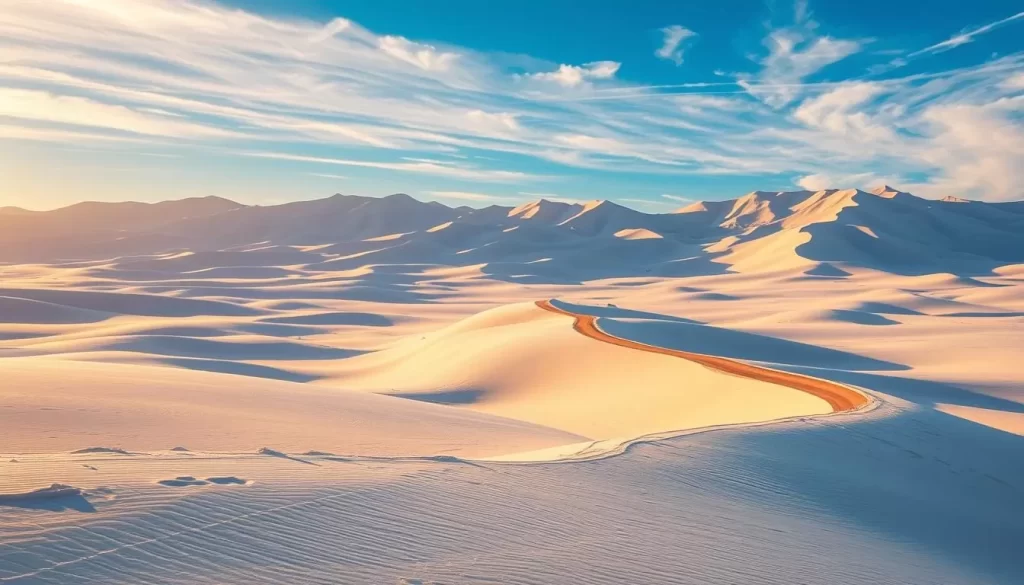
Along Dunes Drive, you’ll find numerous pullouts and parking areas that provide access to trails, picnic spots, and perfect photo opportunities. The loop road system makes navigation easy, ensuring you don’t get lost among the dunes.
| Feature | Description |
|---|---|
| Distance | 16 miles round-trip |
| Road Surface | Paved for the first 4 miles, then packed gypsum sand |
| Driving Time | Approximately 45-60 minutes without stops |
Plan to spend several hours exploring White Sands National Park to fully enjoy the stops along Dunes Drive.
Must-Try Hiking Trails in White Sands
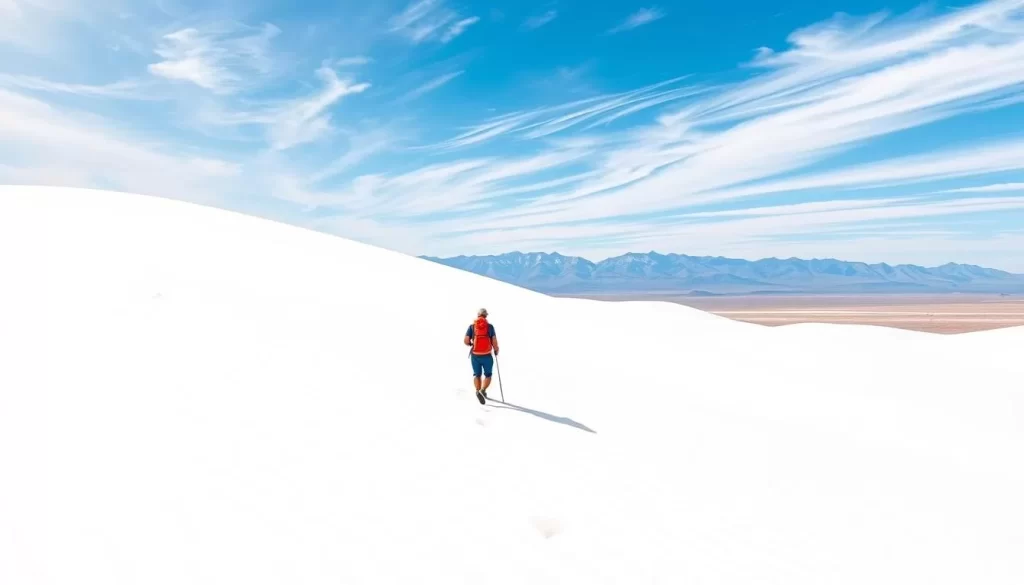
Exploring the diverse hiking trails of White Sands National Park is an experience unlike any other. The park offers a range of trails that cater to different skill levels and preferences, ensuring that every visitor can enjoy the stunning natural beauty of the white sands.
Interdune Boardwalk
The Interdune Boardwalk is a wheelchair-accessible, 0.4-mile trail that takes you out into the dunes via a wooden boardwalk. This trail is not only easy to navigate but also features educational signage about the unique ecosystem. You’ll find shade at the midpoint, making it a comfortable walk even during the peak sun hours.
Playa Trail
For a leisurely walk, the Playa Trail is an excellent choice. Marked with green trail markers, this easy, 0.5-mile level hike takes you through the playa, which is a dry lakebed for most of the year. It’s perfect for families and those with limited mobility.
Dune Life Nature Trail
If you’re looking for a slightly more challenging hike, the Dune Life Nature Trail is a moderate, 1-mile roundtrip hike marked with blue trail markers. This trail showcases the diverse plant life that thrives among the dunes, offering a unique insight into the park’s ecosystem.
Alkali Flat Trail
For experienced hikers, the Alkali Flat Trail is the most demanding hike in the park. Marked with red trail markers, this 5-mile roundtrip hike is a strenuous trek up and down sand dunes. The trail takes you to what was once Lake Otero, providing a truly immersive experience.
To navigate these trails safely, the colored marker system is invaluable, helping prevent visitors from getting lost in the seemingly endless white landscape. Whether you’re looking for an easy stroll or a challenging hike, White Sands National Park has a trail that’s just right for you.
Sledding Down the White Sand Dunes

White Sands National Park offers an exhilarating adventure: sledding down its pristine sand dunes. You can purchase a plastic snow saucer at the visitor center or bring your own saucer sled. Either way, it’s endless fun for both kids and adults, with many sand dunes throughout the park offering great slopes to ride down.
To ensure a smooth and fast ride, it’s crucial to wax your sled before sledding down the white sand dunes. Look for dunes that gently flatten out at the bottom to avoid any accidents. You can buy sleds at the visitor center, or your hotel might offer them for their guests.
- Experience the unique thrill of sledding down pristine white sand dunes – an activity that makes White Sands different from any other national park.
- Learn about the types of sleds that work best on the gypsum sand (plastic snow saucers) and where to obtain them.
- Discover the importance of waxing your sled for a smooth ride down the dunes.
- Find out which areas of the park offer the best sledding experiences.
- Get practical tips for sledding safely, including choosing dunes that flatten out at the bottom.
By following these tips and being mindful of your surroundings, you can have a safe and enjoyable sledding experience at White Sands National Park. So, grab your sled and get ready for an adventure you’ll never forget!
Photography Opportunities in White Sands

With its breathtaking landscapes and unique natural beauty, White Sands National Park is a photographer’s paradise. The park offers a myriad of photography opportunities, from capturing the stunning images of the rippled white sand dunes to experimenting with composition techniques that incorporate sparse vegetation against the white sand.
The best times for photography at White Sands are early morning and late afternoon when the low-angle light creates dramatic shadows across the dunes. To capture pristine, untouched landscape shots, try to find areas without footprints, showcasing the natural wind patterns in the sand.
Some tips for photography at White Sands include:
– Capture stunning images of the rippled white sand dunes that create natural patterns and textures unlike anywhere else in the world.
– Learn the best times for photography at White Sands – early morning and late afternoon when the low-angle light creates dramatic shadows across the dunes.
– Discover how to find pristine areas without footprints for those perfect, untouched landscape shots that showcase the natural wind patterns.
– Experiment with composition techniques that incorporate the sparse vegetation against the white sand for added depth and interest in your photos.
– Understand how wearing colorful clothing can create striking contrast against the white background, making for memorable portrait opportunities.
By following these tips and taking advantage of the unique landscapes at White Sands, you can capture truly memorable photos that reflect the park’s natural beauty.
Ranger Programs and Special Events

Visitors to White Sands National Park can enrich their experience with guided ranger tours and special events. The park offers various programs that provide a deeper understanding of the unique geology, wildlife, and plant adaptations within the park.
By participating in ranger-led programs, you can gain insights into the natural and cultural history of White Sands. Consider joining a sunset or full moon ranger-guided tour to experience the park’s beauty in a unique way. These tours are available subject to the park’s tour status, which can be checked on their website.
Some of the exciting experiences include:
- Enhance your visit by participating in ranger-led programs that provide deeper insights into the park’s unique geology, wildlife, and plant adaptations.
- Experience the magic of a sunset stroll with a knowledgeable ranger who can explain the natural and cultural history of this remarkable landscape.
- Plan your visit around special Full Moon Night events (May through October) featuring live music, guest speakers, and the ethereal experience of moonlit dunes.
- Discover the enchantment of ranger-guided moonlight hikes available from March through December, offering a completely different perspective of the white sands.
- Learn how families with children can participate in the Junior Ranger program, completing fun activities to earn a special White Sands badge.
These programs make a visit to White Sands National Park even more memorable, offering something for everyone to enjoy.
Picnicking Among the Dunes
A picnic among the white sand dunes is an unforgettable experience at White Sands National Park. The park is equipped with around 60 picnic tables spread across three main areas, with the majority located in the Primrose and Roadrunner picnic areas, which are situated next to each other.
The picnic tables are designed with a futuristic flair, featuring an overhang to provide shade, making your dining experience comfortable amidst the stunning landscape. Each table is also equipped with a grill, although you’re welcome to bring your own if you prefer.
- Enjoy your meal surrounded by the breathtaking white dunes at one of the designated picnic areas.
- Appreciate the unique design of the picnic tables that complement the otherworldly scenery.
- Choose from three main picnic areas: Primrose, Roadrunner, and others along Dunes Drive.
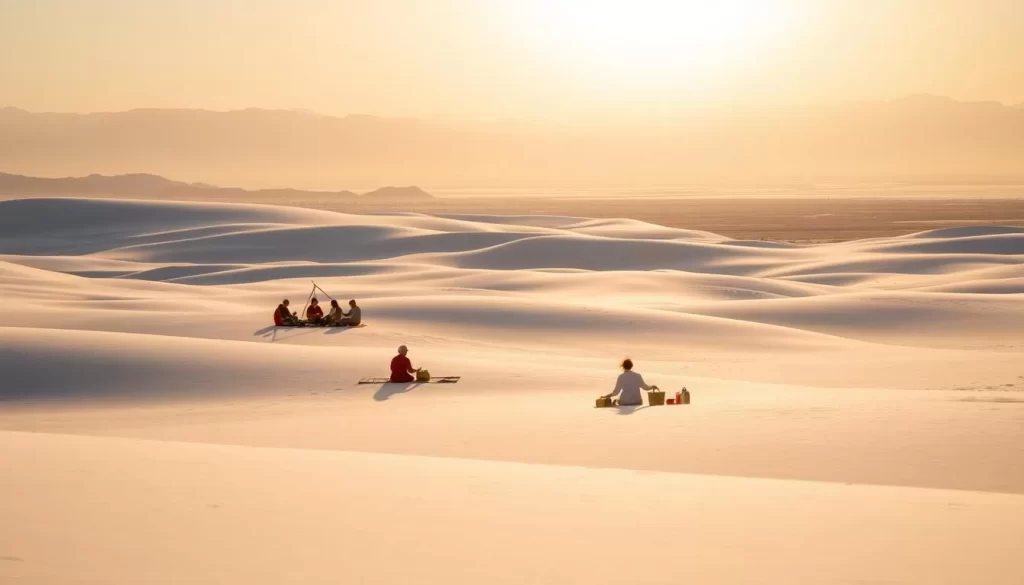
Remember to pack out all trash to preserve the pristine environment of White Sands.
Backcountry Camping Experience
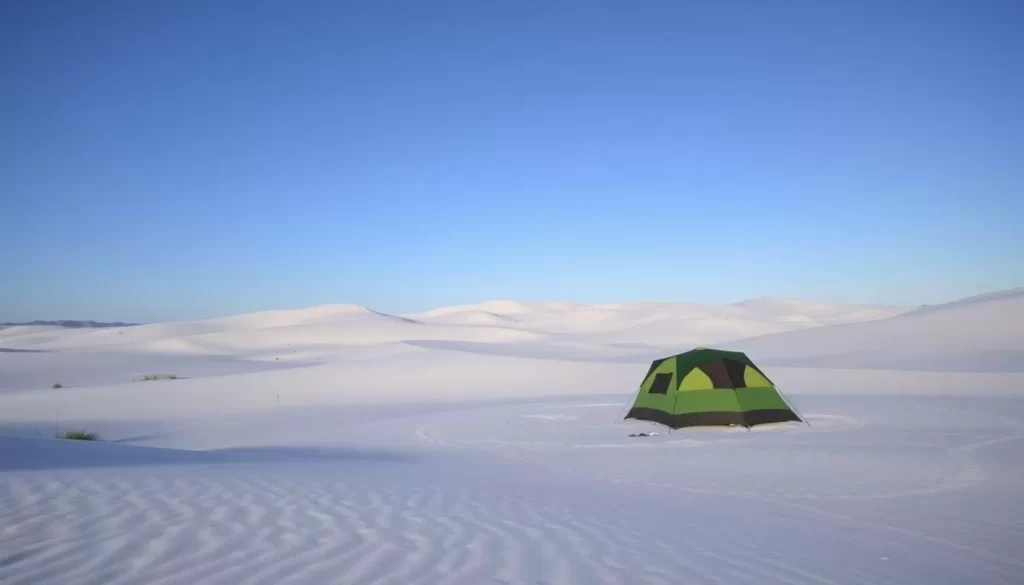
White Sands National Park offers a unique backcountry camping experience amidst its stunning gypsum dunes. The park allows only backcountry camping, with 10 designated campsites that require a 1-mile hike from the main road. The trail is marked by orange markers, guiding you through the dunes to your campsite.
To camp, you must obtain a permit from the visitor center on a first-come, first-served basis. As of this writing, backcountry camping is temporarily closed for site rehabilitation. For updates, check the National Park Service (NPS) website.
Camping in White Sands National Park is a one-of-a-kind experience, offering solitude and incredible stargazing opportunities. Be prepared for the unique challenges of camping on gypsum sand, including securing your tent and managing temperature fluctuations.
Essential Tips for Visiting White Sands
When planning your trip to White Sands National Park, there are several essential tips to keep in mind to ensure a safe and enjoyable visit. The park’s unique environment can be challenging, and it’s easy to get lost among the dunes.
Staying Safe and Hydrated is crucial. Always bring plenty of water and food, especially during the summer when the park is very hot. Drinking water regularly and taking rests is vital to avoid heat stroke.
- Protect yourself from the intense sun with sunscreen, sunglasses, and a wide-brimmed hat, as the reflection off the white sand intensifies UV exposure.
- Stay hydrated by bringing at least one gallon of water per person per day in summer, as there are limited water sources within the park.
- Navigate safely by using trail markers and natural landmarks to avoid getting disoriented among the uniform white dunes.
- Prepare for extreme temperature variations, especially if visiting for sunrise or sunset when desert temperatures can drop dramatically.
- Time your visit strategically to avoid missile testing closures from the nearby White Sands Missile Range, which can temporarily close the park.
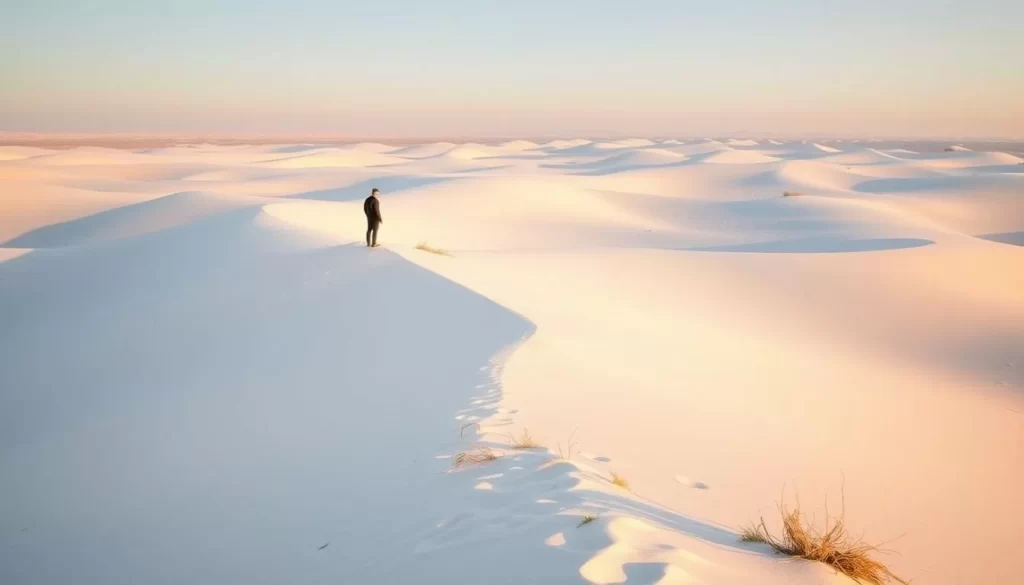
By following these tips, you can have a safe and enjoyable trip to White Sands National Park. Remember to plan ahead, stay hydrated, and be prepared for the unique conditions of the park.
Nearby Attractions Worth Visiting
Beyond the breathtaking white sands, the surrounding region offers a wealth of exciting experiences to enhance your trip. You can explore a mix of history, culture, and entertainment that complements the natural beauty of White Sands National Park.
White Sands Missile Range Museum
The White Sands Missile Range (WSMR) Museum is a must-visit attraction that delves into New Mexico’s rich history, from its natural heritage to its significant role in air defense and the Space Program. With impressive displays of missiles and rockets, this fascinating Department of Defense installation is an exciting learning opportunity for all ages.
Alameda Park Zoo
For a fun-filled day with family, head to the Alameda Park Zoo in Alamogordo, where you can observe diverse wildlife from around the world. The zoo features animals from North America, South America, Australia, Mexico, and Africa, providing an enjoyable and educational experience.
New Mexico Museum of Space History
Expand your knowledge of space exploration at the New Mexico Museum of Space History, which showcases the state’s contributions to space science. The museum features captivating exhibits, an International Space Hall of Fame, and real rockets on display, offering a unique insight into the world of space.
Pistachioland
If you’re a fan of pistachio nuts, don’t miss the quirky roadside attraction of Pistachioland. This unique destination features a 30-foot tall pistachio statue, farm tours, and a variety of delicious flavored pistachios, including regional specialties like Green Chile.
Where to Stay Near White Sands National Park
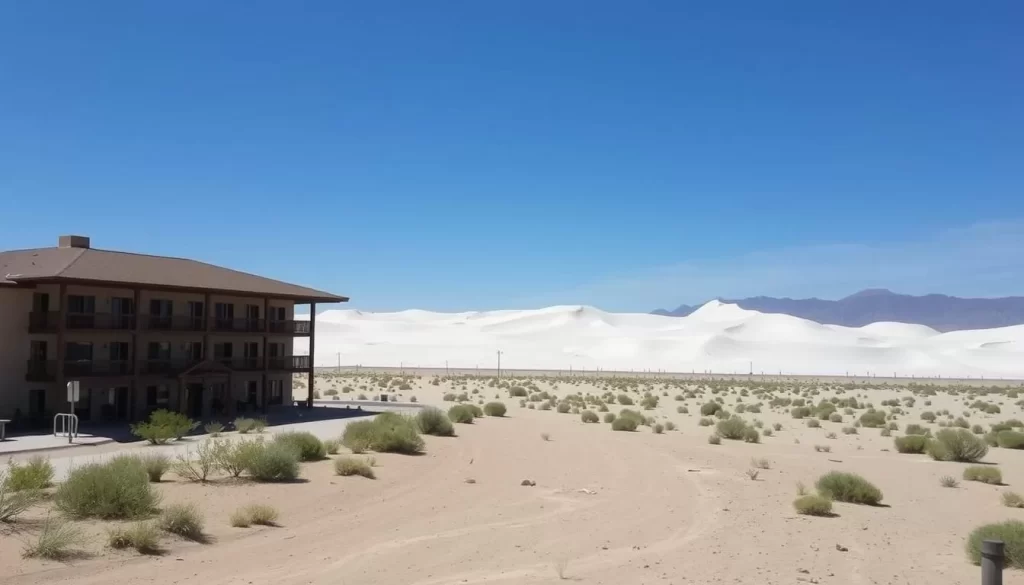
White Sands National Park doesn’t offer lodging within the park, but nearby towns have great options. You can choose to stay in Alamogordo or Las Cruces, each offering unique benefits.
Alamogordo is just 20 minutes from the park entrance and features hotels like Hampton Inn, Fairfield Inn & Suites, and Holiday Inn Express. If you prefer more dining and shopping options, consider staying in Las Cruces, about 50 minutes away, with hotels like Courtyard by Marriott, Hilton Garden Inn, and Ramada.
For those who prefer camping, the Alamogordo-White Sands KOA or Boot Hill RV Resort are great options near White Sands National Park. If you’re planning a broader Southwest road trip, renting a camper van from cities like Phoenix or Las Vegas could be an exciting adventure.
Understanding the pros and cons of each location will help you make the best choice for your visit to White Sands National Park. Whether you prioritize proximity or amenities, there’s a perfect place to stay near this natural wonder.
Conclusion
Visiting White Sands National Park is a chance to explore one of the United States’ most unique natural wonders. The park’s gypsum sand dunes offer an unforgettable experience, whether you’re hiking, sledding, or simply taking in the breathtaking views. You can explore the top sights and trails in half a day, but photography enthusiasts may want to spend up to two days capturing the beauty of the dunes.
White Sands National Park is not only a standout destination but also a protected area, preserving the world’s largest gypsum dunefield for future generations. As part of a larger New Mexico road trip, you can discover other attractions in the southern part of the state, making your trip even more memorable.
With its otherworldly landscape, White Sands National Park offers experiences you won’t find anywhere else in North America, making it a must-visit destination.
The above is subject to change.
Check back often to TRAVEL.COM for the latest travel tips and deals.
